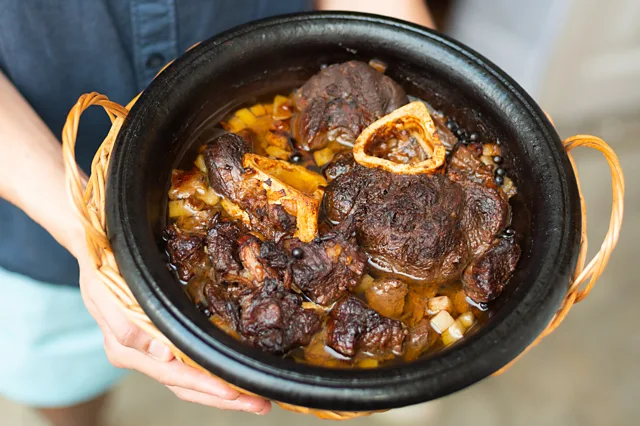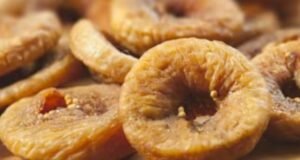
Akin to France’s heartier, spicier, richer boeuf bourguignon, “alcatra” is synonymous with a single island in the remote Azores archipelago.
The Azores, an archipelago of nine islands belonging to Portugal and located roughly between Europe and the US, are cow country. They’re said to be home to more cattle than people, and despite being home to less than 3% of Portugal’s population, the islands produce 30% of Portugal’s dairy products and 13% of its beef.
Beef is part of everyday life in the Azores, and come spring on one particular island, the ingredient even crosses paths with religion.
In the days following Easter, Azorean people kick off a series of religious celebrations called Festas do Espírito Santo (Festivals of the Holy Spirit). During the 13th Century, a Catholic sect called the Cult of the Holy Spirit predicted a utopian era on Earth. This fringe faith was discouraged in mainland Europe but lived on in these remote islands in the middle of the Atlantic Ocean. The sect was also promoted by Portuguese queen Elizabeth of Aragon (also known as Elizabeth of Portugal), who was known for her charity.
Over the subsequent centuries, a series of festivals emerged on the Azores that blended these utopian aspirations with the queen’s alleged generosity. Between Easter and the week following Whitsunday, a total of eight weeks, the islands host a series of parades and other cultural and religious festivals that revolve around brightly coloured community houses called impérios. During this time, the community houses also collect donations from locals, which is then redistributed to people in the form of bread, beef and wine.
These three elements generally come together in the form of a soup, called sopa do Espírito Santo, that’s served at the impérios during the festivals. But on the island of Terceira, locals combine these ingredients in a different and delicious way, one that’s become synonymous with the island’s culinary identity.
“People eat alcatra year round, but especially during the celebrations in spring and summer,” explains Duarte Fournier. He is the Grand Master of the Brotherhood of Alcatra, a culinary fraternity on Terceira, and is telling me about the island’s signature dish: cuts of beef braised in local wine, smoked pork fat and dried spices, resulting in something of a heartier, spicier, richer version of France’s famed boeuf bourguignon.
We’re sitting at a cafe in Angra do Heroísmo, Terceira’s largest city, and as we chat, children race to and from a nearby império delivering massive trays of raw beef to neighbours. Fournier tells me that alcatra likely has its origins in northern Portugal, where there’s a tradition of baking goat in wine.
“We don’t know why it’s called alcatra,” he says. “We suppose it’s from Arabic. Al catar means ‘small pieces of meat’.”
According to Fournier, alcatra differs from mainland Portugal’s baked meat dishes in that it includes dried spices, generally allspice and black peppercorns, but also sometimes clove or cinnamon.
“Spices came to Terceira on trading boats,” says Fournier, referencing Portugal’s expansive maritime trade network, which, from as early as the 16th Century, included points in Africa, modern-day India, China, Southeast Asia and the Americas – the origins of many of the dried spices we use today. “They would come with spices and leave with fruit.”
Fournier insists that the beef for alcatra must come from grass-fed cows – standard on Terceira – and that at least one of the cuts should have a bone, both factors that contribute to the taste of the dish. He adds, “An old cow is better for alcatra. It takes longer to cook, which means it has a better flavour in the end.”
With these tips and background information, I approach my friend, a chef and native of Terceira, José Sousa, to ask if he would be willing to make alcatra. Sousa works in Lisbon but was visiting home, which meant that he would be making the island’s most traditional and celebrated dish not just for me, but also for his parents and grandparents – all natives of Terceira.
We start by visiting Sousa’s grandmother to get the family alguidar, the tapered, hand-thrown clay vessel used to bake alcatra. After decades of use, the pot is stained a dark, almost black hue.
“The alguidar gets seasoned like a cast iron pan, and the dish comes out even better,” Sousa says, adding that the alguidar is something of a family heirloom that gets passed down generation to generation.
Sousa’s father had already received beef from an império, so we continue around Angra do Heroísmo on foot in search of the remaining ingredients. At Bertílio Simões & Irmãos, a grocery store that dates to 1860, we stop for dried spices.
 Weekly Bangla Mirror | Bangla Mirror, Bangladeshi news in UK, bangla mirror news
Weekly Bangla Mirror | Bangla Mirror, Bangladeshi news in UK, bangla mirror news







